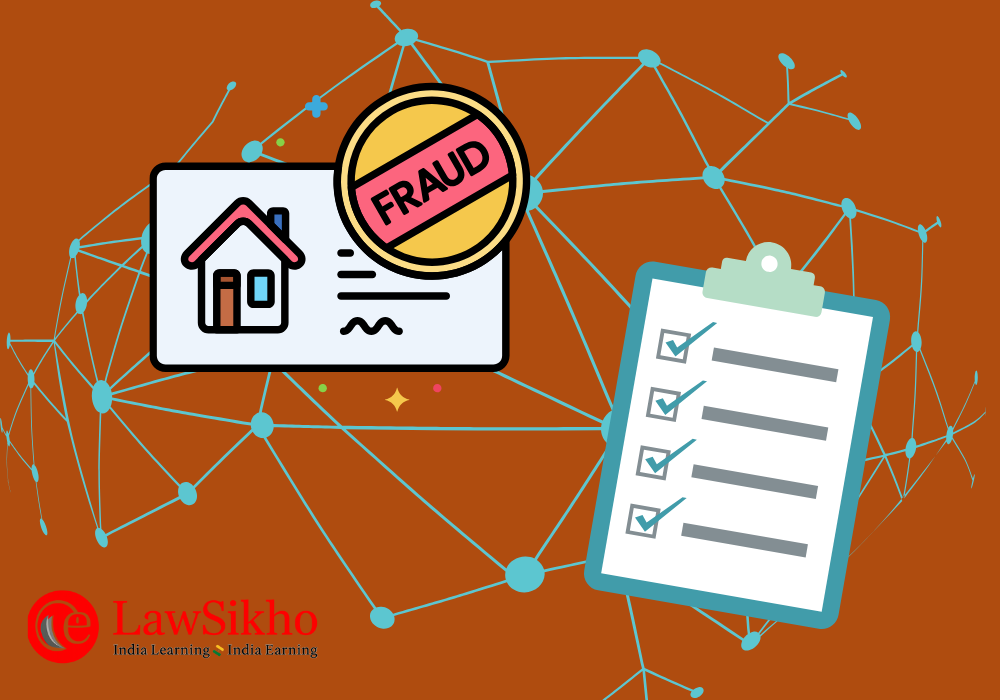In the second part of this four-part article series, you will learn how AI can revolutionise property due diligence for lawyers handling real estate transactions in India. From spotting forged power of attorney documents to exposing fake ownership chains, this article walks you through prompts, AI-generated checklists, and fraud detection techniques. Whether you are a real estate lawyer, or criminal lawyer, or a real estate investor, this article will equip you with the much-needed practical skills.
Table of Contents
Introduction
Previously, we uncovered how property fraud in India has evolved, from forged documents to builder scams, while most lawyers still rely on outdated methods. We argued that prevention, not just prosecution, is the future of property law.
In this Part, I will show you how to build AI-powered due diligence systems that catch red flags human eyes often miss.
“The documents looked perfect, the stamps were genuine, and the seller had all the right answers, until we discovered the property had been sold to three different buyers in the same month.”
If you are a real estate lawyer, you have probably seen this nightmare scenario play out. Traditional due diligence, with its paper trails and manual cross-checks, is like bringing a magnifying glass to a gunfight against increasingly sophisticated fraudsters.
But here is what I discovered when handling a complex property fraud case earlier this year: Artificial intelligence is not just changing how we research case law or draft contracts. It is revolutionising how we think about property investigation itself.
This is not another article about AI replacing lawyers. This is about how smart lawyers are using AI to catch fraud that human eyes miss, build a solid due diligence system, and turn property investigation from an art into a science.
Let me walk you through exactly how it works.
Let us discuss the facts at hand
Three months ago, Meera Sharma walked into my office with what looked like a textbook property transaction. She wanted to buy a 3BHK resale flat in Sector 76, Noida. The seller seemed legitimate; he had a registered sale deed from 2021, a power of attorney from 2020, updated utility bills, and a clean encumbrance certificate.
But something felt wrong. Maybe it was the seller’s urgency to close within a week. Or the society residents’ welfare associate (RWA) mentioned that this flat had changed hands four times in five years. Or the power of attorney that was surprisingly vague about sale rights.
In the old days, I would have spent three days manually cross-checking documents, making phone calls, and hoping I did not miss anything crucial. Instead, I decided to try something different: I let AI help me think through this systematically.
What happened next probably saved Meera from losing Rs. 1.2 crores to an organised fraud ring.
Step-wise guide to preparing a due diligence checklist using AI
This guide uses Claude.ai to assist with due diligence. Free tiers or legal-specific AI tools can also work, provided they handle complex prompts and legal analysis.
Step 1: Setting the foundation – Teaching AI to think like a real estate lawyer
The first challenge with using AI for legal work is context. You can not just throw documents at it and expect magic. You need to teach it to think like a suspicious lawyer who has seen every trick in the book.
Why this prompt matters- Before diving into document analysis, AI needs to understand the specific legal landscape, the common fraud patterns in your jurisdiction, and the particular red flags for your type of case. Think of this as briefing a new junior associate, except this one has perfect memory and infinite patience.
The prompt I used:
“Act as an experienced real estate lawyer in India. I’m advising a client purchasing a resale flat in Sector 76, Noida, from a seller claiming authority through a registered Power of Attorney. The property has changed hands 4 times in 5 years, according to the society RWA. I need a comprehensive due diligence checklist that covers title verification, power of attorney validity, ownership chain analysis, and regulatory compliance. Assume high fraud risk and include modern investigation techniques.”
AI’s response (Key excerpts):
Immediate red flag assessment:
- Multiple ownership changes in a short timeframe suggest layering or benami transactions
- Vague POA language often indicates insufficient authority for property sale
- Urgent timeline pressure is a classic fraud manipulation tactic
Primary investigation areas:
- Title chain verification: Obtain certified copies of all sale deeds from 2010-present, not just the immediate seller’s documents
- POA scrutiny: Verify registration details, confirm principal’s current status, and check for specific sale authorisation clauses
- Cross-reference validation: Match property details across revenue records, municipal databases, and society records
- Pattern analysis: Investigate relationships between previous buyers/sellers, unusual price movements, and transaction timing
Modern verification tools:
- RTI applications for original document verification
- Google Earth historical imagery for physical verification
- Digital signature verification through government portals
- Cross-checking with relevant regulatory databases
Instead of my usual 20-point generic checklist, I now had a 40-point investigation framework specifically tailored to this fact pattern. More importantly, AI had identified investigation angles I had not considered, like using RTI to verify the original POA registration details and checking for pattern relationships between previous owners.
Step 2: Dissecting the Power of Attorney
The seller’s POA looked official: registered, stamped, and notarised. But appearances can be devastating in property law. I needed AI to help me think through the legal nuances that could make or break this transaction.
Why this prompt matters- Power of attorney law in India is technical and specific. A POA that looks valid to a layperson might be legally worthless for property transactions. AI can help spot these technical deficiencies faster than manual legal research, especially when you frame the question correctly.
The prompt I used:
“Analyse this Power of Attorney document legally. It’s registered in 2020 and states the holder may ‘manage the property on behalf of the principal’ and ‘act as principal’s representative in all property matters.’ There’s no explicit mention of ‘sale’ or ‘execution of sale deed.’ The principal is elderly and hasn’t been contacted directly. Is this POA legally sufficient for executing a sale deed under Indian law? What specific legal deficiencies should I flag?”
AI’s response:
Legal insufficiency analysis:
Indian courts consistently hold that:
- General words like “manage property” or “act as a representative” are insufficient for a property sale
- POA must explicitly state authority to “sell,” “execute sale deed,” and “appear before Sub-Registrar”
- Vague language creates legal vulnerability for both buyer and seller
Critical missing elements:
- No specific sale authorisation: “Manage property” ≠ “, authority to sell”
- Missing registration formalities: No mention of Sub-Registrar appearance rights
- Absent consideration handling: No authority mentioned for receiving the sale proceeds
- Verification gap: No recent confirmation from principal (POA is 5 years old)
Recommended actions:
- Demand a fresh POA with specific sale authorisation
- Insist on direct principal verification through video call/personal meeting
- Check the principal’s current mental and legal capacity
- Verify no subsequent revocation of the POA
The POA was legally insufficient for the property sale. In traditional practice, I might have caught this during a detailed review, but AI flagged it immediately and provided the specific case law backing. More importantly, it suggested practical steps for remedy, demanding a fresh POA or direct principal involvement.
This analysis alone probably saved Meera from a transaction that could have been challenged in court later.
Step 3: Investigating the ownership
Four sales in five years. In Mumbai or Delhi, this might indicate genuine market activity. In Noida’s residential sector? This screams systematic fraud or money laundering. I needed AI to help me design an investigation strategy for this ownership pattern.
Why this prompt matters- Frequent property transfers often mask complex fraud schemes, from benami transactions to money laundering operations. Human investigators might miss subtle patterns across multiple transactions, but AI can spot systematic anomalies that reveal coordinated deception.
The prompt I used:
“This property has changed ownership 4 times in 5 years: 2019, 2020, 2021, 2022, and now 2025. Create an investigation checklist to determine if these are genuine market transactions or part of a systematic fraud/laundering pattern. Include both documentary verification and pattern analysis techniques.”
AI’s response:
Pattern Analysis Framework:
1. Relationship Mapping:
- Cross-check surnames, addresses, and phone numbers of all previous buyers/sellers
- Verify PAN and Aadhaar linkages for identity overlap detection
- Check for common witnesses across multiple sale deeds
- Analyse notary and document writer patterns
2. Financial Pattern Review:
- Compare consideration amounts against market rates for each transaction year
- Flag unusual appreciation/depreciation patterns
- Check for round-number considerations (often indicates artificial pricing)
- Verify stamp duty payments match the declared consideration
3. Timeline Suspicious Indicators:
- Sales occurring within 3-6 months of purchase (insufficient time for genuine occupancy)
- Multiple sales in the same calendar year (tax evasion indicator)
- Transaction dates coinciding with regulatory changes or enforcement activities
4. Possession and Utility Analysis:
- Verify the actual possession transfer between each sale
- Check the electricity and water bill name changes corresponding to the sale dates
- Confirm property tax payment responsibility shifts
- Investigate the society transfer certificates and NOCs
5. Documentation Forensics:
- Compare handwriting samples across different sale deeds
- Check for identical document formatting or template usage
- Verify different registration numbers and sub-registrar offices
- Analyse the photograph and map consistency across transactions
Following AI’s checklist, I discovered that three of the four previous sales involved variations of the same surname (Kumar, Kumar Singh, Kumari), two transactions happened within 45 days of each other, and the property tax payments had never actually changed hands, they were all paid by the same bank account.
This was not market activity. This was an elaborate layering operation designed to create a false ownership trail.
Step 4: Government records cross-verification
Government records do not lie; they just hide the truth behind multiple departments and acronyms. I needed AI to help me design a comprehensive verification strategy across different government databases.
Why this prompt matters- Property fraud often succeeds because buyers only check obvious documents like sale deeds and encumbrance certificates. But government records across multiple departments tell a more complete story. AI can help you think systematically about which departments to query and what questions to ask.
The prompt I used:
“Design a comprehensive government record verification checklist for a resale flat in Noida. Include specific departments, documents needed, and red flags to watch for. Cover revenue records, municipal approvals, utility connections, and any applicable regulatory compliance for resale properties. Think like a forensic investigator trying to catch document fraud.”
AI’s response:
Multi-Department Verification Matrix:
Revenue Department (Tehsildar Office):
- Khasra/Survey number verification and history
- Mutation entries from the original allotment to the current
- Land classification changes (agricultural to residential)
- Any pending revenue court cases or disputes
Noida Authority Records:
- Original plot allotment letter and conditions
- Building plan approvals and modifications
- Occupancy Certificate and Completion Certificate
- Any violations or penalty notices
Sub-Registrar Office:
- Original registration documents (not just certified copies)
- Cross-verification of registration numbers and dates
- Stamp duty payment verification
- Document writer and witness verification
Municipal Corporation:
- Property tax assessment history and payment status
- Building permit and completion records
- Water and sewerage connection approvals
- Any demolition or violation notices
Additional Regulatory Checks (if applicable):
- For newer projects: RERA registration status verification
- Environmental clearance compliance (for large complexes)
- Fire safety clearance and lift approvals
- Society registration and legal status
Utility Verification:
- Electricity connection history and bill payment pattern
- Water connection authorisation and usage pattern
- Gas connection records (if applicable)
- Internet/cable connection histories
Cross-Reference Red Flags:
Inconsistent Property Details:
- Different plot/flat numbers across departments
- Varying carpet area measurements
- Conflicting property boundaries or descriptions
Timeline Anomalies:
- Utility connections predating construction completion
- Property tax assessments before building approvals
- Occupancy before completion certificate issuance
Authorisation Gaps:
- Building plan not matching actual construction
- Missing approvals for structural modifications
- Violations pending resolution
The cross-verification exposed that the building had significant deviations from the approved plan, there were pending violation notices from 2020 that were never resolved, and most concerning, the electricity connection was in a different name entirely, suggesting the claimed ownership chain was fabricated.
Step 5: Third-party verifications
Why this prompt matters: Third-party confirmations provide independent validation of ownership, possession, and compliance, catching fraud that government records might miss.
The prompt I used:
“Build a checklist for third-party verifications for a resale flat in Noida. Include checks with the society RWA, builder/developer, and other stakeholders. Specify documents to request, questions to ask, and red flags indicating fraud. Focus on confirming possession, dues, and legal status.”
AI’s response:
- RWA Checks: Verify transfer records, NOC issuance, maintenance dues, and disputes.
- Builder Checks: Confirm original allotment, resale approvals, and project compliance.
- Red Flags: Mismatched owner names, unpaid dues, or missing NOCs.
This step would make the guide more comprehensive and align with the master checklist’s scope.
Step 6: The final AI-generated master checklist
After several hours of AI-assisted investigation, here is the comprehensive due diligence checklist that emerged, specifically tailored to catch the kind of advanced fraud Meera almost fell victim to:
The prompt I used:
“I need you to consolidate all our previous due diligence analysis into one comprehensive, actionable checklist for property lawyers in India. Structure it as a master reference document that covers every aspect we’ve discussed: title verification, power of attorney scrutiny, government records verification, pattern analysis, and third-party confirmations.
Make it practical and specific – each item should be something a lawyer can actually execute, not vague suggestions. Include both the ‘what to check’ and ‘what to look for as red flags’ for each category.
Organise it with clear headers and sub-categories so busy lawyers can quickly find the relevant section for their specific concern. This should be the kind of checklist that, if followed completely, would catch the sophisticated fraud patterns we identified in Meera’s case.
Focus on actionable items that can prevent fraud, not just detect it after the fact. Include modern verification techniques alongside traditional legal checks.”
AI’s response:
You can find the AI’s response here.
Step 7: Prepare an infographic
Since this article is quite text-heavy, I have turned the content into an easy-to-digest infographic for better readability. If you would like to generate a similar infographic, use the following prompt:
The prompt I use:
“Convert our detailed property due diligence checklist into a compact, single-page infographic. Use a card-based grid layout with 6 main sections, each containing 6-8 key verification points. Add a prominent red flags warning section and a verification tools section. Design it as a professional reference tool for lawyers. Focus on visual hierarchy and space efficiency while maintaining all essential fraud detection elements.”
AI’s response
A streamlined guide for detecting property fraud in India
Why this approach works
Since implementing this AI-enhanced due diligence process, the results speak for themselves:
Time efficiency: What used to take 4-5 days of manual investigation now takes 6-8 hours of focused, systematic verification.
Pattern recognition: AI helped identify fraud patterns that human analysis might miss, like the subtle relationship mapping between previous “unrelated” buyers.
Comprehensive coverage: Instead of hoping I remembered to check everything, AI ensures systematic coverage of all verification angles.
Legal precision: AI helps frame technical legal questions more precisely, leading to more accurate legal analysis.
But here is the crucial point: AI did not replace legal judgment; it amplified it. Every red flag AI identified still required human legal analysis. Every document inconsistency still needed lawyer expertise to evaluate. Every fraud pattern still requires a strategic legal response.
The bottom line
Property fraudsters have embraced technology, advanced document manipulation, and psychological pressure tactics. They operate like organised crime syndicates with dedicated teams for forgery, legal evasion, and victim selection.
Meanwhile, many real estate lawyers are still fighting these complex operations with manual document reviews and hope.
The choice is simple: evolve your practice methods or watch your clients become statistics in fraud case studies.
AI-assisted due diligence is not the future of real estate law; it is the present reality for lawyers who want to stay ahead of increasingly organised criminals. When you master these techniques, you are not just protecting individual clients; you are contributing to a legal ecosystem where property fraud becomes too risky and unprofitable to attempt.
The technology exists. The training is available. Start with one low-stakes property verification case this week. Use AI to enhance, not replace, your legal analysis. Join legal technology communities where practitioners share AI prompts and techniques. Most importantly, begin building your own AI-enhanced due diligence protocols before your next client needs them.
Coming up in Part 3: How to use AI for drafting bulletproof police complaints, including specific prompts for gathering facts, structuring the complaint, and ensuring all essential elements are covered for maximum prosecution impact. We’ll also explore AI templates for RERA complaints that have resulted in faster resolution and higher compensation awards. So stay tuned.






 Allow notifications
Allow notifications
